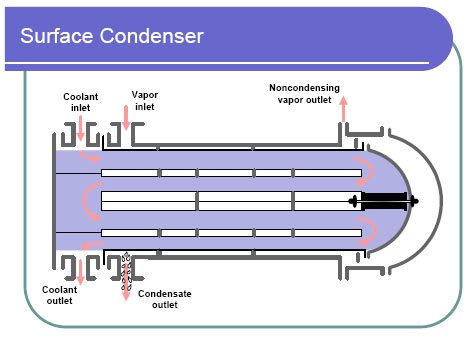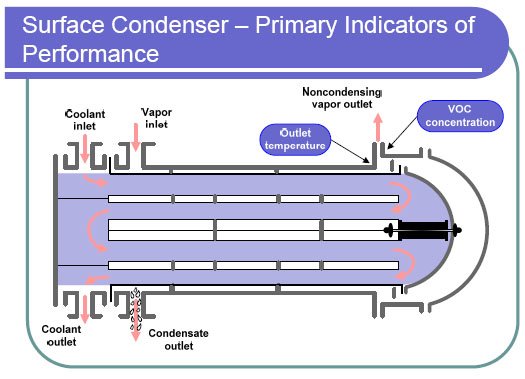Monitoring by Control Technique - Condensers
Description
Condensers are used to convert condensible components of a gas stream to the liquid phase, usually by reducing the temperature of the gas stream. Condenser efficiencies vary from 50 to 95 percent, and are dependent on the type of gas stream entering the condenser and on the condenser operating parameters (e.g., coolant temperature). Gas stream properties such as the number of pollutants, chemical and physical properties of those pollutants, moisture content, particulate matter content, flow rate, and temperature all affect how well the condenser operates. Condensers can be classified as either contact condensers or surface condensers. In contact condensers, the exhaust gas comes into direct contact with the coolant. In surface condensers, the coolant typically is circulated through a series of tubes around which the exhaust gas flows.
Condensation occurs when the partial pressure of the condensible pollutant in the waste gas stream is equal to its vapor pressure as a pure substance at the outlet gas temperature of the condenser. The waste gas stream is cooled by transfer of its heat to a refrigerant or coolant. The temperature at which the gases condense can be predicted from vapor pressure data for the pollutant and its mole fraction in the waste gas stream. The temperature required to achieve a given removal efficiency or outlet concentration depends on the inlet conditions of the waste gas stream. A condenser is designed for a maximum pressure and temperature. Normal operation of a condenser should include an outlet gas maximum temperature set point and a fixed inlet and outlet coolant/refrigerant temperature. The outlet gas temperature is a critical indicator of the efficiency of a condenser. Several operating parameters may be used to indicate good operation of the condenser, including: outlet pollutant concentration of the most volatile pollutant, outlet temperature of the waste gas stream, inlet temperature of the waste gas stream, temperature of the condensate pool, inlet temperature of the coolant, and outlet temperature of the coolant.
A training tool developed for inspectors provides an overview of condensation; this tool describes condenser types, operating principles, pollutants controlled, proper operating conditions, and performance monitoring of condensers. A training video provides similar information in an audio-video format (about 15 minutes in length). Other specific information about condensers can be found from the EPA Air Pollution Control Cost Manual, Section 3.1, Chapter 2 - Refrigerated Condensers and from the EPA Technical Bulletin - Refrigerated Condensers for Control of Organic Emissions.
For more information, see the box More About Condensers.
Monitoring Information
The primary indicators of the performance of condensers are the condenser outlet VOC concentration and condenser outlet gas temperature. Other parameters that indicate condenser performance include coolant inlet temperature, coolant outlet temperature, exhaust gas flow rate, pressure differential across condenser, coolant flow rate, pressure differential across coolant recirculation system, and condensate collection rate.
The Compliance Assurance Monitoring (CAM) Technical Guidance Document (TGD) provides a source of information on monitoring approaches for different types of control devices. Specific information provided in the CAM TGD related to condensers includes example CAM submittals based on case studies of actual facilities. Use the link below to access Appendix A: Example CAM Submittals for Condensers.
For more information, see the box Monitoring and the CAM Rule.
To search for additional monitoring information specific to an industry, see the monitoring information by industry type page.
Costs
Costs of condensers are discussed in the EPA Air Pollution Control Cost Manual*, Section 3.1, Chapter 2 - Refrigerated Condensers (pdf) (139 KB). Costs of monitoring systems, both Continuous Emission Monitors and parametric monitoring systems, are addressed in the EPA Air Pollution Control Cost Manual*, Section 2, Chapter 4 - Monitors (pdf) (542 KB).

- Air Pollution Control Cost Manual*, Section 3.1, Chapter 2 - Refrigerated Condensers (pdf) (2 MB).
- EPA Technical Bulletin - Refrigerated Condensers for Control of Organic Emissions (pdf) (2 MB)
- Training Video- Air Pollution Control Devices - Condensation (MP4) (zip)

- CAM Rule (pdf) (408 KB) - Federal Register - October 22, 1997
- CAM TGD - Appendix A: Example CAM Submittals for Condensers
